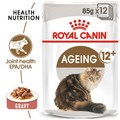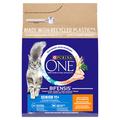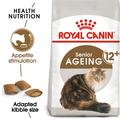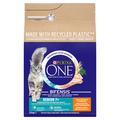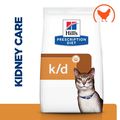Compared with some animal species, the life expectancy of domestic cats is relatively long, and, thanks to advances in medicine, is only going to increase. On average, cats will live 12-15 years, with some entering their early 20's and beyond.
A one year old cat is comparable to a 20 year old human, with every subsequent year adding four years to its human age equivalent. Therefore, a cat that is 16 years old will developmentally be the same as an 80 year old human; in fact the oldest cat on record lived to the grand old age of 38, equivalent to 168 in human years!
So, we know cats are long lived; indoor cats, especially. But, like us, they do age and undergo change. This usually happens above the age of 10, when your cat is equivalent to 56 in human years. Their metabolisms slow, their joints stiffen, their whiskers turn grey and they can no longer do, or eat, the things they used to enjoy.
As an owner, it is difficult seeing this change, but maturity is just another stage of development and, while it usually brings some detriment, there are ways to manage its effect for the comfort and longevity of your cat. Learning about the golden years early will help you to identify changes when they occur, so that you can distinguish what is normal from what is cause for concern.
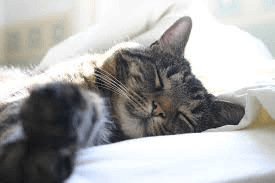 During ageing, various changes occur. Activity levels decrease, muscle tone reduces and there may be a degree of sensory loss. Appetite and fluid intake will change, along with bowel and urinary systems function, and the immune system may weaken. A cat's physical appearance i.e. coat condition, is also likely to deteriorate, and behavioural/personality changes will be evident.
During ageing, various changes occur. Activity levels decrease, muscle tone reduces and there may be a degree of sensory loss. Appetite and fluid intake will change, along with bowel and urinary systems function, and the immune system may weaken. A cat's physical appearance i.e. coat condition, is also likely to deteriorate, and behavioural/personality changes will be evident.
Age associated disorders such as arthritis, kidney disease, and diabetes become much more prevalent after 8 years of age, so it is important to be aware of these. It is also important to keep on top of vaccinations and flea and worm treatments as, even though your cat is ageing, it is not exempt from these problems.
While most considerations for the older cat are fairly obvious, it doesn't hurt to be reminded. Sometimes, it is the little things we haven't even thought of that make the biggest difference to a senior cat. Things like where we put the litter tray and how much we feed our cat are important as it enters its twilight years.
In the wild, cats are most vulnerable when they are eating, sleeping, and going to the toilet so having their wits about them is essential if they are to avoid attacks. As cats age, they are less vigilant to threat and cannot react with the same speed as when they were younger, so having the litter tray outside, where the cat is going to feel most exposed, may discourage it from going there. This also goes for the food and water bowls if they are usually placed outside. Move them in; while this will encourage your cat to visit them, it has the added benefit of allowing you to keep an eye on your cat's eating and drinking habits every day.
Bear in mind what your cat is eating and how much it is drinking. Cats are notoriously bad at the latter and therefore need as much moisture as they can get from their food. Elderly cats are very prone to dehydration as they have smaller appetites and therefore consume less water. As cats age, they need to keep their weight up and maintain an ideal body mass. While gradual weight loss often goes hand in hand with ageing, it can also be the first sign of a serious illness, such as cancer, diabetes and kidney disease. Any weight loss should be investigated by your vet before a diet plan is made.
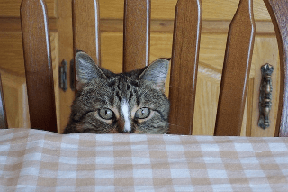 If your cat is eating less through natural ageing, try to encourage smaller meals more often. Choose a quiet area to place the food bowl and experiment with familiar and unfamiliar foods to tempt your cat's appetite. Some older cats, especially those with dental problems, may prefer a softer food than regular biscuits or hard chunks.
If your cat is eating less through natural ageing, try to encourage smaller meals more often. Choose a quiet area to place the food bowl and experiment with familiar and unfamiliar foods to tempt your cat's appetite. Some older cats, especially those with dental problems, may prefer a softer food than regular biscuits or hard chunks.
Also, remember to clean your cat's teeth regularly, as wet food can leave soft deposits along the gumline, leading to tartar and plaque. Add a little extra water to the food to help its passage through the digestive tract and keep your cat hydrated.
Most cats have a favourite spot they like to sit and observe from. Unfortunately, as cats get older, accessing these places becomes impossible. Give your cat a helping hand by placing a ramp up to the sofa/windowsill/bed to assist arthritic joints and ensure your cat still gets to enjoy its treasured lookouts and chillout areas.
Also, consider where you put the litter tray, food and water bowls, scratching posts and cat toys, as elderly cats tend to have a hard time getting upstairs. If you notice your cat has become a bit sluggish, move these things to somewhere more accessible. If a bed is placed up high, move it somewhere lower down so your cat can rest without having to struggle. Likewise, consider horizontal rather than vertical scratching posts so your cat doesn't have to stretch.
Ageing is a completely natural process and it needn’t be traumatic. By understanding how your cat’s needs have changed, just as they did moving from a kitten to an adult, and modifying aspects of lifestyle, diet and care, you can reinforce and maximise health, whilst maintaining a good standard of living whatever your cat’s age, requirements, and personality.
If you have any advice on caring for an older cat, please share it with our other readers! Feel free to contact me directly with any further questions and/or suggestions for future blog posts: [email protected].
Written by: Hannah

